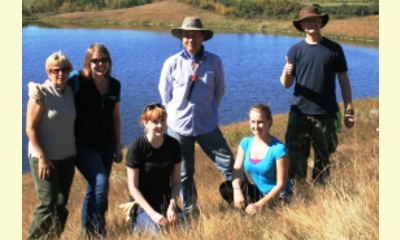|
|
Exploring new ways of connecting people with nature
an article by Nature Conservancy of Canada (abridged)
How can we expect someone to care about nature if
they've had no personal experience with it?
Endangered species, critical habitats,
biodiversity — though we deal with these concepts
every day at the Nature Conservancy of Canada
(NCC), they are abstract, intangible and foreign
to many.

NCC staff and volunteers tackling invasive species at Collins property, Red Deer River Natural Area, Alberta (Photo by NCC)
click on photo to enlarge
In our fast-paced, urbanized world, exposure to
nature is decreasing and people are less connected
to their surroundings. As a result, we are far
less likely to make informed, sustainable choices
and understand the full extent of our impacts on
the environment. It all comes back to giving
people the opportunity to learn and connect with
nature by experiencing it first-hand.
Through our Conservation Volunteers program we are continually
looking for new ways to engage people in our work
and provide meaningful, educational (and fun!)
experiences in nature. In my three years as
coordinator for the program in Alberta, I have
witnessed the positive effects of education and
engagement.
Keen to find new ways to connect our supporters
and volunteers with nature, I travelled to
Baltimore, Maryland this past October to attend
the 42nd annual North
American Association for Environmental Education
conference. The conference explored seven
different environmental education themes,
including:
• connecting kids with nature
• conservation education and behaviour change
• greening formal education
• leadership and innovation
• sustainable communities
• public participation in scientific research
(also known as citizen science)
The use of technology as an engagement tool was a
hot topic, especially the use of mobile apps. The
California Academy of Sciences is currently using
the popular iNaturalist
app to engage people in documenting California’s
biodiversity through photos. Not only is this
initiative increasing environmental literacy among
the public, it is also furthering biodiversity
research.
Similarly, professional and amateur birders are
using the iBird
app to document their sightings and learn more
about the various species they encounter. Both
apps harness the power of community. They provide
a platform where people can share knowledge and
connect with other nature lovers around the world.
. .
The Nature Conservancy (U.S.) provides paid four-
week summer internships for high school students
every year through its LEAF
program (Leaders in Environmental Action for the
Future). By targeting urban youth from populations
that are less engaged in conservation, the program
seeks to empower future conservation leaders in
the areas where they are needed most.
The Cornell Lab of Ornithology’s Celebrate
Urban Birds is another program that’s
successfully engaging new audiences in nature and
citizen science. By focusing on birds (a familiar
species that can be spotted in cities), the
program empowers urban underserved communities to
collect and track observations of 16 focal species
and contribute to ornithological research. They
accomplish this by educating people about the
birds in their backyard and offering communities
mini-grants to organize and participate in
greening efforts — efforts that result in even
more habitats for urban birds! It’s a powerful
model that incorporates community, arts and the
environment. . . .
[Note. Thank you to Janet Hudgins, the CPNN reporter
for this article]
|








|
DISCUSSION
Question(s) related to this article:
How can we encourage people to care for the environment?,
* * * * *
LATEST READER COMMENT:
Nature is fascinating! Children are walking, or crawling, sponges--starting from scratch--and that's the right time to input the right stuff.
So talk about birds. They are always visible and audible. They call each other, listen to what they are saying. Cheerilee, dee dee, caw caw, and which beautiful songs come from which birds. They are perfect pilots, they swoop and dive and do barrel rolls and never have an accident (unless we do something stupid). Crows marry for as long as they live.
Youngsters' interest is easily piqued but parents have the responsibility to do it (so they might bone up on nature). . ...more.

|
|









